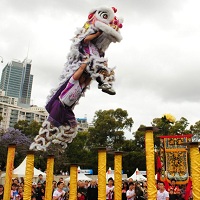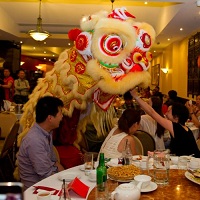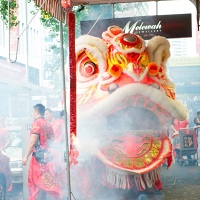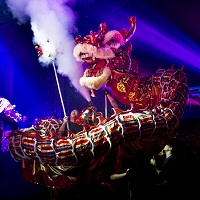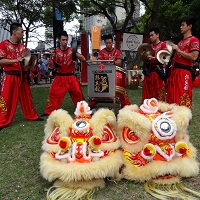Welcome
We are a Sydney based Dragon and Lion dance troupe. We are a young and dynamic team who endeavour to be the best troupe in Australia.
We have represented Australia in numerous international competitions in countries including China, Hong Kong, Malaysia and Singapore. We maintain rigorous training schedules to ensure that we remain one of the top teams in Australia, and are always ready for any type of performance, large or small.
Our performances employ modernised props which add to the memorable experience without compromising on the traditional culture, beauty and history of Lion Dance.
We perform for all types of occasions, specialising in weddings, shop and restaurant openings, and large corporate events.
Lion dance 舞獅 (wǔ shī) is a form of traditional Chinese dance, in which performers mimic a lion’s gestures and emotions to tell a story and bring luck to places where they perform. The lion dance movements embody the beauty, culture and history of ancient China, and combine martial arts with performance arts. The movements are sourced from Chinese martial arts, and were historically also used to demonstrate a school’s technique and fitness. The custom of lion dance dates back some two thousand years with records of performances during the Qing and Han Dynasties.
Today, lion dances are used for celebrating and bringing luck to any special occasion. While the amount of performances culminates around Chinese New Year, lion dances occur year round for all occasions, including shop openings, weddings, special functions and other celebrations.
During the performance, the lion will perform the traditional custom of “cai qing” (採青), literally meaning “plucking the greens”, whereby the lion plucks the auspicious green vegetables like lettuce either hung on a doorway or placed on a table in front of the premises. The “qing” is tied together with a “red packet” containing money and may also include auspicious fruit like oranges. In Chinese, cǎi (採, pluck) also sounds like cài (菜, meaning vegetable) and cái (财, meaning fortune). The lion will dance and approach the “qing” and “red packet” like a curious cat, to “eat the qing” and “spit” it out but keep the “red packet” which is a token of appreciation for the performers.
JWK maintains rigorous training schedules to ensure we are always ready to perform at an international standard.
Lion Dance
Lion Dance on Poles
Jin Wu Koon prides itself as one of Australia’s few lion dance troupes that perform freestyle lion dance on poles. In these performances, the lion jumps on poles up to 3 metres high and over distances up to 2 metres in length.
Jin Wu Koon has consistently competed at the international level over the last 6 years, representing Australia in competitions in many countries, including Malaysia, Singapore, Hong Kong and China.
We are also Australia’s only troupe that perform with props such as fire hoops, high wires and falling poles. Each performance lasts for 10-15 heart pumping minutes, which are sure to get keep audiences on the edge of their seats.
Lion Dance on Floor
Jin Wu Koon is also one of Australia’s oldest traditional lion dance troupes. The troupe has trained many generations of traditional lion dance performers since being established in 1975.
Traditional floor performances are just as exciting as freestyle pole performances, and can accommodate any sized venue with multiple lions performing at the same time. Floor performances involve acrobatic stunts, jumping over obstacles such and allow for a lot of audience interaction. These performances incorporate props such as benches, pots, wine jugs and baby lions, and can be performed even in modestly sized areas.
Australia’s Largest Lion
Jin Wu Koon boasts Australia’s largest lion head. The giant lion head is a great attraction for any event, and is great for photo opportunities.
Whether used for performances or as a prop for your function, it’s always a instant crowd pleaser.
Dragon Dance
Large Dragon
For especially large areas, we have a 40 metre dragon which is great for exhibitions and big functions.
Drum & Music Routine
Music and drum performances are performed using the traditional Chinese drums, cymbals and gongs.
These performances are very loud and great for attracting a lot of attention and bringing an energising atmosphere to your event.
Martial Arts
For information regarding Kickboxing, Kung Fu, and Jiu Jitsu demonstrations or workshops, please click here to contact the Jin Wu Koon Double Dragon Martial Arts Academy.
Orphaned at the age of ten, Jin Wu Koon’s Grandmaster, Chan Keng Wan, was adopted by Tai San’s Sifu Serng, Master of the Hong Ga Fist Style. Sifu Ng Serng recognised the valuable qualities of patriotism, respect for tradition and endurance in his protégé and began grooming him as the future Jin Wu Koon Grandmaster. The Shaolin Buddha Fist Style, the Short and Long Arm back fist strikes, Single Head Dragon Pole, Broadsword, Spear and the generations old Shaolin Die Da medical skills for treating bone injuries comprised the impressive repertoire taught by Sifu Ng Serng.
Chan Keng Wan continued his pursuit of Kung Fu skills in SunHui with Sifu Chan Ngai, Master of the Jin Wu Academy. Sifu Chan Ngai taught the traditional Shaolin Choi Lee Fut styles and also the Six and a half step pole.
Two years later, at 22 years of age, Chan Keng Wan established his own academies in Suihui, ZhongSan, TaiSan, HaiPing, YenPing and HocSun. At this time he met Sifu Ng Dak Sam of Guangxi Province from whom he learned the Northern Style of Double Dragon Fists, Double Flying Butterfly sword, the Willow Sword and the Deadly Eighteen Step Spear.
During the 1930’s, while China was at war with the invading Japanese army, local military officers organised guerrilla fighters of their districts into the Chinese Army. Chan Keng Wan was recruited at this time into the 19th Army led by Zau Hon Leng of Sun Hui. Sifu Chan was soon appointed as the Broad Sword combat instructor, leading raids into enemy camps.
When peace was declared in 1946, Sifu Chan returned to teaching his academies where he had been appointed, now as chief instructor. Later the same year, the Jin Wu Koon establishment was officially registered with the Canton local authorities at JianMen.
After China was liberated by the Communists, Grand Master Chan Keng Wan went to Hong Kong where he established the Keng Wan Gymnasium and Dia Da Medical Clinic for the treatment of bone injuries. Whilst living in Hong Kong, Grand Master Chan Keng Wan accepted the position of voluntary Die Da Medical Consultant for Hong Kong’s largest football association. He also accepted the position of voluntary doctor at the headquarters for Hong Kong’s Department of Health and Hygiene.
Grand Master Chan was invited to welcome the noble emissary, Prince Phillip to Hong Kong in 1949. All his disciples joined in the formal demonstrations to commemorate the occasion.
In 1967 Grand Master Chan was employed by the Malaysian Karate Budokan headquarters as medical advisor, and as instructor for the Chinese Double Dragon Pole, Broadsword and Spear. As Master of the Buddha Fist Style, he often traveled back to Hong Kong to give public demonstrations of his unique Double Dragon Fists, considered to be the best even amongst Kung Fu Masters.
It is this background of skills that was passed onto his youngest son, Master Cheuk Fai Chan. With this knowledge, Master Cheuk Fai Chan literally fought his way to the top. He competed in karate, kung fu and kickboxing, winning many tournaments and titles and the respect of other martial artists. It is this incredible history of traditional knowledge and his influence of practical experience that Master Cheuk Fai Chan has used to found the Jin Wu Koon Australian Headquarters in Sydney.






